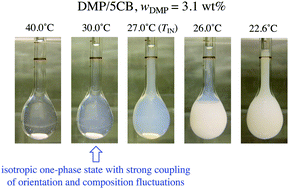Phase equilibrium and dielectric relaxation in mixture of 5CB with dilute dimethyl phthalate: effect of coupling between orientation and composition fluctuations on molecular dynamics in isotropic one-phase state†
Abstract
Phase equilibrium and dielectric relaxation were examined for mixtures of liquid-crystalline (LC)-forming 4-cyano-4′-pentylbiphenyl (5CB) with dilute dimethyl phthalate (DMP). The mixtures were in an isotropic one-phase state at high temperatures T but were separated into nematic and isotropic phases at low T < TIN (isotropic-to-nematic transition temperature), and the isotropic phase disappeared and a nematic one-phase state was realized on a further decrease of T below another transition temperature  . These TIN and
. These TIN and  data (phase diagram) were described considerably well by a simple model of free energy contributed from a Flory–Huggins type mixing entropy (no enthalpic contribution) and a Landau–de Gennes type nematic interaction. This success of the model, not expected for ordinary (not LC-forming) components exhibiting enthalpically-driven phase separation, suggested that the phase separation in the DMP/5CB mixtures was triggered by the nematic transition of 5CB (possibly governed by the packing entropy) and thus the orientation fluctuation of 5CB molecules was coupled with the composition fluctuation. This coupling was expected to affect the dielectric relaxation detecting the rotational dynamics of 5CB molecules, the major component in the mixtures. This expectation was examined for a representative mixture having the DMP content of wDMP = 3.1 wt% and TIN ≅ 27.0 °C. In a high-T asymptote (T > TIN + 10 °C), the dielectric relaxation of this mixture was close to that of pure 5CB, which suggested no significant effect of the above coupling on 5CB dynamics in the mixture at such high T. Nevertheless, in a significantly wide range of T between TIN and TIN + 10 °C, the dielectric relaxation time τε of the isotropic one-phase mixture increased on cooling much more significantly compared to τε in that high-T asymptote. The kinematic viscosity ν of the mixture exhibited a qualitatively similar increase in the same range of T, but this increase was weaker than that of τε. This difference between the dielectric τε and the rheological ν was attributed to coupling of the orientation and the composition fluctuations mentioned above. Namely, the composition fluctuation enhances the orientation fluctuation in the mixture thereby providing τε (reflecting the orientation fluctuation) with an extra increase. Pure 5CB exhibited similar increases of τε and ν (stronger for the former) but only in a close vicinity of
data (phase diagram) were described considerably well by a simple model of free energy contributed from a Flory–Huggins type mixing entropy (no enthalpic contribution) and a Landau–de Gennes type nematic interaction. This success of the model, not expected for ordinary (not LC-forming) components exhibiting enthalpically-driven phase separation, suggested that the phase separation in the DMP/5CB mixtures was triggered by the nematic transition of 5CB (possibly governed by the packing entropy) and thus the orientation fluctuation of 5CB molecules was coupled with the composition fluctuation. This coupling was expected to affect the dielectric relaxation detecting the rotational dynamics of 5CB molecules, the major component in the mixtures. This expectation was examined for a representative mixture having the DMP content of wDMP = 3.1 wt% and TIN ≅ 27.0 °C. In a high-T asymptote (T > TIN + 10 °C), the dielectric relaxation of this mixture was close to that of pure 5CB, which suggested no significant effect of the above coupling on 5CB dynamics in the mixture at such high T. Nevertheless, in a significantly wide range of T between TIN and TIN + 10 °C, the dielectric relaxation time τε of the isotropic one-phase mixture increased on cooling much more significantly compared to τε in that high-T asymptote. The kinematic viscosity ν of the mixture exhibited a qualitatively similar increase in the same range of T, but this increase was weaker than that of τε. This difference between the dielectric τε and the rheological ν was attributed to coupling of the orientation and the composition fluctuations mentioned above. Namely, the composition fluctuation enhances the orientation fluctuation in the mixture thereby providing τε (reflecting the orientation fluctuation) with an extra increase. Pure 5CB exhibited similar increases of τε and ν (stronger for the former) but only in a close vicinity of  (within 2–3 °C), because the orientation fluctuation in pure 5CB is coupled with the density fluctuation, not with the composition fluctuation being absent in the pure 5CB system. This behavior of pure 5CB in turn suggests an importance of the coupling of orientation and composition fluctuations in the mixture.
(within 2–3 °C), because the orientation fluctuation in pure 5CB is coupled with the density fluctuation, not with the composition fluctuation being absent in the pure 5CB system. This behavior of pure 5CB in turn suggests an importance of the coupling of orientation and composition fluctuations in the mixture.



 Please wait while we load your content...
Please wait while we load your content...